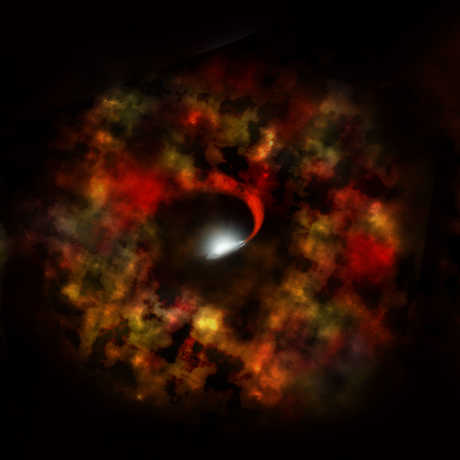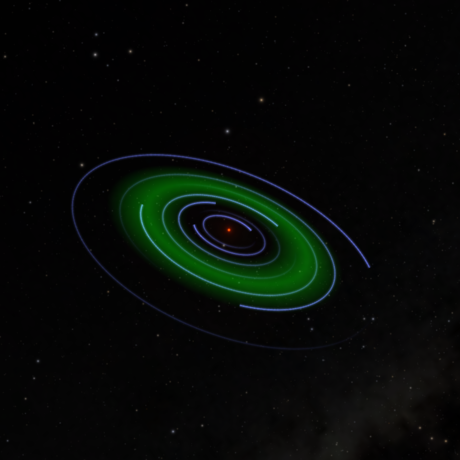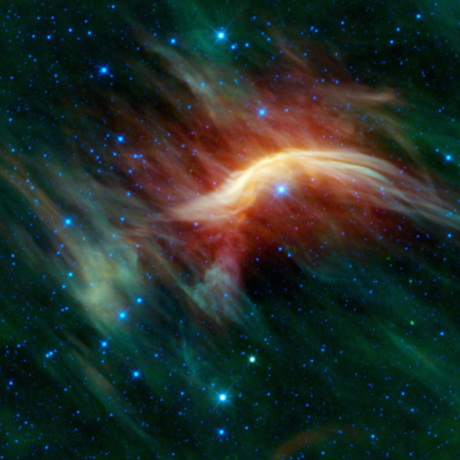Science News
Cryovolcanism, Spitzer, Oldest Stars, and Alien Calls

Cryovolcanism on Ceres
Ahuna Mons rises 4,000 meters (13,000 feet) high and spreads 18 kilometers (11 miles) wide at its base. This would be impressive for a mountain on Earth, but Ahuna Mons stands on Ceres, a dwarf planet less than 1,000 kilometers (600 miles) across and the largest object in the asteroid belt between Mars and Jupiter.
And this week, using data collected from NASA’s Dawn mission, scientists have discovered another impressive thing about Ahuna Mons: volcanism. But not just any volcanism. “After studying it closely,” says Arizona State’s David A. Williams, “we interpret it as a dome raised by cryovolcanism.”
Cryovolcanism is a form of low-temperature volcanic activity, where molten ice—water, usually mixed with salts or ammonia—replaces the molten silicate rock erupted by terrestrial volcanoes. Giant mountain Ahuna is a volcanic dome built from repeated eruptions of freezing salty water. And newly built, according to Williams and his colleagues. Using models to determine the age of Ahuna Mons, the team found that it formed after the craters surrounding it, which suggests that it came into existence relatively recently.
Ahuna Mons is not the only place where icy volcanism happens on Ceres. Dawn’s instruments have spotted features that point to cryovolcanic activity that resurfaces regions rather than building tall structures. Numerous craters, for example, show floors that appear flatter than impacts by meteorites would leave them, so perhaps they have been flooded from below. In addition, such flat-floored craters often show cracks suggesting that icy “magma” has pushed them upward, then subsided.
The team says this cryovolcanism confirms that although Ceres’ surface temperature averages almost –40° (Celsius or Fahrenheit, since the scales converge at this temperature), its interior has kept warm enough for liquid water or brines to exist for a relatively long period. And this has allowed volcanic activity at the surface in recent geological time. –Molly Michelson
Spitzer Beyond
This week, NASA announced the name of the Spitzer Space Telescope’s 30-month mission extension. Starting October 1, the infrared space-based observatory will begin its “Beyond” phase and focus on a range of astronomy topics, from exoplanets to cosmology. And yes, the name is a direct reference to the 3rd installment of the latest Star Trek franchise.
Launched on August 25, 2003, Spitzer is the fourth and final installment of NASA’s Great Observatories Program, which includes the Hubble Space Telescope, the Chandra X-ray Observatory, and the defunct Compton Gamma Ray Observatory. Each space-based observatory was designed not just to observe different wavelengths of light (with Spitzer designed for infrared detection), but also to overcome a significant challenge in astronomy—Earth’s atmosphere—which distorts or even blocks certain wavelengths from reaching our planet’s surface. In particular, most parts of the infrared spectrum are unobservable from Earth, so Spitzer was designed for deep space infrared studies.
This will be the mission’s third, and potentially final, phase. When launched, the craft was equipped with a 0.85-meter telescope and three cryogenically-cooled instruments, the Infrared Array Camera (IRAC), Infrared Spectrograph, and a Multiband Imaging Photometer, with the latter two requiring a superfluid helium coolant to function. The liquid helium, along with solar shields and strategic positioning, cooled the craft to near absolute zero (–273°C or –459°F). This was necessary because the infrared light Spitzer was built to observe is primarily heat radiation—and heat from the craft itself, the Sun, and even Earth, could all potentially interfere with observations. In its initial “Cryogenic” mission phase from 2003 through May 2009, all three of these instruments functioned together, generating a remarkable amount of data—and scientific publications!
In 2009, Spitzer used the last of its superfluid helium coolant, ending its primary “cold” phase and beginning its “warm” second phase. The temperature on board rose to a toasty –242°C (–404°F), which still allowed the IRAC instrument to still see through the visible-light-blocking dust that permeates our galaxy and observe in limited infrared wavelengths to view the heat glow from a range of objects such as asteroids, nebulae, protoplanetary disks, gas-giant planets, and distant galaxies.
The adaptability of Spitzer has proved extremely valuable so far and will continue to play a role in the ongoing success of its extended mission. In fact, many of the selected research proposals for the Beyond phase, also called Cycle 13, include objects Spitzer was not originally designed to observe. Exoplanets, for example. As Sean Carey of NASA’s Spitzer Science Center explains: “We never even considered using Spitzer for studying exoplanets when it launched. It would have seemed ludicrous back then, but now it’s an important part of what Spitzer does.”
Despite this, Spitzer has made great contributions to exoplanetary studies. In 2005, a mere two years after launch, the telescope captured the first detection of light from known exoplanets.
Additionally, Spitzer’s list of notable accomplishment include generating a complete census of forming stars in nearby nebulae, first identifying a type of carbon molecules called “buckyballs” in space, and generating the largest, most detailed infrared portrait of our home galaxy. Spitzer has also been used in collaborations with other scopes including a joint discovery with Hubble that the most distant galaxies known are more massive and mature than expected.
The planned end of Spitzer’s Beyond phase roughly coincides with the scheduled 2018 launch of NASA’s James Webb Space Telescope (JWST), which will also be exploring the Universe in infrared. Director of Morrison Planetarium Ryan Wyatt described the state of the JWST project in a 2014 Science Today post, and progress in the last several years has kept it on schedule for its launch in a couple years. But in the meantime, Spitzer has plenty of work to do!
“Spitzer is operating well beyond the limits that were set for it at the beginning of the mission,” said Michael Werner, the project scientist for Spitzer at NASA’s Jet Propulsion Laboratory in Pasadena, California. “We never envisioned operating 13 years after launch, and scientists are making discoveries in areas of science we never imagined exploring with the spacecraft.” –Elise Ricard
Did E.T. Call?
On August 27, the Centauri Dreams blog reported that Russian scientists at the RATAN-600 radio telescope had detected an unusually strong, two-second radio burst from outer space. It appeared to come from the direction of a Sun-like star called HD 164595, located 95 light years away in the constellation Hercules and already known to be orbited by a Neptune-size planet. Not unexpectedly, the mass mediapicked up the story and ran with it.
Was the signal an attempt at communication by an alien civilization, or some natural phenomenon? On the face of it, the incident seemed reminiscent of the legendary “Wow!” signal that was detected by Ohio State University’s Big Ear radio telescope in 1977, and which was never heard again. Noted experts on the topic of searching for extraterrestrial intelligence were quickly consulted, among them Douglas Vakoch of METI International and Jill Tarter, Seth Shostak, and Franck Marchis of the SETI Institute (all of whom have given presentations at the Academy at different times as part of the Benjamin Dean Astronomy Lecture series at Morrison Planetarium).
As Marchis pointed out on his own blog, the detection actually took place in May 2015, more than a year before it was made public. The team apparently plans to make a presentation about it later this month at the 67th International Astronautical Congress (IAC) in Guadalajara, Mexico. International protocols that were previously agreed to stipulate that the astronomical community be alerted to any signal of interest as soon as possible so that other observatories can corroborate the observation. This was not done, impeding any possible efforts to quickly verify the data. In that time, however, the Russian team has made 39 subsequent observations of HD 164595 without detecting a repeat signal, and the SETI Institute has used its Allen Telescope Array in northern California to try to pick up a signal, but without success. Likewise, Dan Werthimer of the Breakthrough Listen and SETI@Home organizations reports that the Breakthrough team has scanned the vicinity of HD 164595 using the 100-meter Robert C. Byrd radio dish at Green Bank, West Virginia, at the same frequencies used by the RATAN scientists and detected nothing unusual.
Also, Marchis and Tarter point out that the RATAN-600 instrument is not exactly a high-precision device. Its unconventional design leads SETI scientists to question its ability to pinpoint the source of the signal, and they suggest that it may more likely have misidentified an Earthly signal.
In an update written for the SETI Institute’s homepage, Shostak noted the strength of the alleged signal and estimated that that to be as strong as it was after traveling the 94 light year distance from HD 164959, the source would had to have been enormously powerful—broadcasting at a minimum of a trillion watts, or twice the annual electrical consumption of the entire U.S. Besides, if it came from a civilization 94 light years away, how would they have known where to send it? Humanity’s radio signals haven’t yet reached that far into space, so if there’s anyone just beyond, they wouldn't be aware of us yet.
On the other hand, if—instead of a tightly focused beam—the signal was sent in all directions, Shostak calculates that it would require 100 million times more energy still, amounting to hundreds of times more than the total amount of sunlight shining on Earth. In either case, we simply don’t have nearly enough power plants, windmills, solar cells, and hamster balls to generate that much energy.
In light of all the excitement and skepticism raised by the Centauri Dreams post, Yulia Sotnikova of the Special Astrophysical Observatory of the Russian Academy of Sciences issued an official statement on Wednesday, clarifying that the signal was most likely of Earthly origin and that “no sought-for signal has been detected yet.”
So it seems the story has quickly been debunked and defused, and scientists and SETI enthusiasts are coming back down to Earth, but as Shostak points out, false-positives happen all the time in SETI—it goes with the territory and should be expected. That in itself, however, is no reason to stop searching for signs that we might not be alone in the Universe.
It's still an awfully big universe, and you never know what you’ll find until you look. –Bing Quock
Oldest Stars
When we gaze at the night sky, we see myriad stars speckling the dark of night. (Or the hazy fog of night, if you live in San Francisco…) Stars truly light up the Universe, and the first stars significantly changed the Universe. Astronomers use supercomputers to calculate these effects, but because the first stars appeared very long ago, it has proven challenging to determine when they initially came on the scene.
It sounds counterintuitive, but to find the earliest objects in the Universe, we need to look for the oldest light—the light that has been traveling longest to reach our telescopes. The farther out in space we look, the farther back in time we see, so we see the Universe when it was very young, a long time ago.
It turns out that, although the youngest stars and galaxies we observe date to an epoch hundreds of millions years after the Big Bang, we can actually detect light much older than that—dating to a time when the Universe was merely 380,000 years old! The cosmic microwave background (CMB) is in fact the oldest light we can observe, released into the Universe as it cooled from its original hot, dense state to the more, well, spacious environment we know today.
So what does this have to do with the first stars? Well, the period of time between the CMB and those ancient young galaxies holds many mysteries for astronomers… Including the formation of the first stars and the first galaxies. We like to call it the cosmic “Dark Ages.”
The “darkness” of the ages applies not just metaphorically to our ignorance but also to the physical nature of the Universe at the time: without stars, the Universe was a pretty dark place!
The European Space Agency (ESA) launched its Planck mission to study the CMB, and because the CMB light has traveled through the Dark Ages, it holds clues to what happened in that timeframe. The main effect is on the polarization of light. When the first stars ignited, their radiation ionized the gas (mostly hydrogen), leading to a state much like the time before the CMB, albeit in a Universe far less dense than it was at the beginning. Astronomers, inventively enough, call this the reionization of the Universe.
A recent announcement from the Planck team reveals that reionization took place much later than previously thought… About 700 million years after the Big Bang! (Not all that long before those ancient galaxies we observe.) So the first stars probably appeared on the scene much later than previously thought—earlier estimates were just a few hundred million years after the Big Bang.
Furthermore, it suggests that stars worked quickly to reionize the Universe, because by 900 million years after the Big Bang, the job was pretty much done. (Yeah, 200 million years sounds like a long time, but it’s not an astronomically long time.)
The Universe expands, stretching light to longer wavelengths, so to see stars and galaxies at great distances, we need to look at longer, infrared wavelengths instead of in visible light. That made the Spitzer Space Telescope a powerful tool, but as described above, NASA’s JWST will pick up where Spitzer leaves off. Understanding the first light in the early Universe is indeed part of the rationale for JWST: the new mission will help us peer back to a time when the first stars and galaxies were taking shape, shedding light on the cosmic Dark Ages. Stay tuned. –Ryan Wyatt
Image: Timeline of the Universe, ESA – C. Carreau


